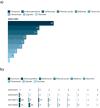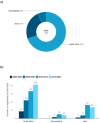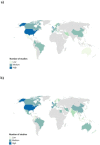A Review of Registered Clinical Trials on Dietary (Poly)Phenols: Past Efforts and Possible Future Directions
- PMID: 33158145
- PMCID: PMC7694232
- DOI: 10.3390/foods9111606
A Review of Registered Clinical Trials on Dietary (Poly)Phenols: Past Efforts and Possible Future Directions
Abstract
In recent years, the increasing number of studies on polyphenol demonstrates the efforts in elucidating the potential role of these bioactives on human health. This study reviews the main topics and characteristics of clinical trials on polyphenols registered over the last 20 years, in order to track past and current efforts as well as to highlight the main research gaps in this field. The review was conducted by collecting trials registered in ClinicalTrials.gov and International Standard Randomised Controlled Trial Number (ISRCTN) registry. Overall, 750 clinical trials were selected and included in the final evaluation. Most of the trials were performed on extracts or pure compounds followed by studies conducted on polyphenol-rich foods, in particular berries. A total of 520 clinical trials focused on health effects, 55 on bioavailability, and 175 on both. Regarding outcomes, 139 registered intervention studies had the lipid profile and blood pressure as primary outcomes. The overview provided by this analysis also emphasizes the emerging interest in new outcomes related to polyphenols intervention such as microbiota composition and the evaluation of inter-individual variability in response to the intake of polyphenols. Our review underlines the need of further trials covering unexplored or debated research aspects and provides insights for the design and development of future intervention studies and related research areas.
Keywords: bioactive compounds; clinical trials; food; food extracts; health outcomes; human nutrition.
Conflict of interest statement
The authors declare no conflict of interest.
Figures









Similar articles
-
An Overview of Registered Clinical Trials on Glucosinolates and Human Health: The Current Situation.Front Nutr. 2021 Oct 27;8:730906. doi: 10.3389/fnut.2021.730906. eCollection 2021. Front Nutr. 2021. PMID: 34778334 Free PMC article. Review.
-
Factors influencing the cardiometabolic response to (poly)phenols and phytosterols: a review of the COST Action POSITIVe activities.Eur J Nutr. 2019 Nov;58(Suppl 2):37-47. doi: 10.1007/s00394-019-02066-6. Epub 2019 Sep 6. Eur J Nutr. 2019. PMID: 31492975 Free PMC article. Review.
-
The future of Cochrane Neonatal.Early Hum Dev. 2020 Nov;150:105191. doi: 10.1016/j.earlhumdev.2020.105191. Epub 2020 Sep 12. Early Hum Dev. 2020. PMID: 33036834
-
DIet and Health From reGIstered Trials on ClinicalTrials.gov: The DIGIT Study.Front Nutr. 2022 Apr 25;9:870776. doi: 10.3389/fnut.2022.870776. eCollection 2022. Front Nutr. 2022. PMID: 35548571 Free PMC article.
-
What Is the Current Direction of the Research on Carotenoids and Human Health? An Overview of Registered Clinical Trials.Nutrients. 2022 Mar 11;14(6):1191. doi: 10.3390/nu14061191. Nutrients. 2022. PMID: 35334849 Free PMC article. Review.
Cited by
-
Highlights on the Role of Galectin-3 in Colorectal Cancer and the Preventive/Therapeutic Potential of Food-Derived Inhibitors.Cancers (Basel). 2022 Dec 22;15(1):52. doi: 10.3390/cancers15010052. Cancers (Basel). 2022. PMID: 36612048 Free PMC article. Review.
-
An Exploratory Critical Review on TNF-α as a Potential Inflammatory Biomarker Responsive to Dietary Intervention with Bioactive Foods and Derived Products.Foods. 2022 Aug 21;11(16):2524. doi: 10.3390/foods11162524. Foods. 2022. PMID: 36010524 Free PMC article. Review.
-
Plant Polyphenols as Heart's Best Friends: From Health Properties, to Cellular Effects, to Molecular Mechanisms of Action.Int J Mol Sci. 2025 Jan 22;26(3):915. doi: 10.3390/ijms26030915. Int J Mol Sci. 2025. PMID: 39940685 Free PMC article. Review.
-
A Healthful Plant-Based Diet as an Alternative Dietary Approach in the Management of Metabolic Dysfunction-Associated Steatotic Liver Disease.Nutrients. 2024 Jun 26;16(13):2027. doi: 10.3390/nu16132027. Nutrients. 2024. PMID: 38999775 Free PMC article. Review.
-
The TOTUM-63 Supplement and High-Intensity Interval Training Combination Limits Weight Gain, Improves Glycemic Control, and Influences the Composition of Gut Mucosa-Associated Bacteria in Rats on a High Fat Diet.Nutrients. 2021 May 7;13(5):1569. doi: 10.3390/nu13051569. Nutrients. 2021. PMID: 34066988 Free PMC article.
References
-
- PubMed. [(accessed on 30 April 2020)]; Available online: https://pubmed.ncbi.nlm.nih.gov/
-
- Adebooye O.C., Alashi A.M., Aluko R.E. A brief review on emerging trends in global polyphenol research. J. Food Biochem. 2018;42:e12519. doi: 10.1111/jfbc.12519. - DOI
-
- Abbas M., Saeed F., Anjum F.M., Afzaal M., Tufail T., Bashir M.S., Ishtiaq A., Hussain S., Suleria H.A.R. Natural polyphenols: An overview. Int. J. Food Prop. 2017;20:1689–1699. doi: 10.1080/10942912.2016.1220393. - DOI
-
- D’Archivio M., Filesi C., Di Benedetto R., Gargiulo R., Giovannini C., Masella R. Polyphenols, dietary sources and bioavailability. Ann. Ist. Super. Sanita. 2007;43:348–361. - PubMed
LinkOut - more resources
Full Text Sources
Miscellaneous

